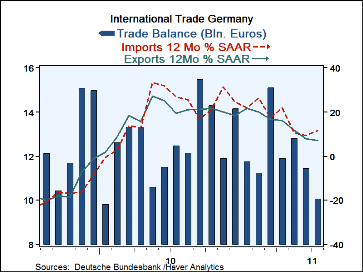 Global| Sep 08 2011
Global| Sep 08 2011German Trade Trends Slip
Summary
German exports fell by 1.8% in July after falling by 1.2% in June. But the preceding months found German exports very volatile rising by 4.3% in May falling by 5.6% in April and surging by 7.2% in March and so on. With volatility like [...]
 German exports fell by 1.8% in July after falling by 1.2% in June. But the preceding months found
German exports very volatile rising by 4.3% in May falling by 5.6% in April and surging by 7.2% in March
and so on. With volatility like that it is hard to pin down trends. But exports do seem to have slowed, to
a three-month growth rate of 5% from 10.8% over six months and 6.9% over 12-months.
German exports fell by 1.8% in July after falling by 1.2% in June. But the preceding months found
German exports very volatile rising by 4.3% in May falling by 5.6% in April and surging by 7.2% in March
and so on. With volatility like that it is hard to pin down trends. But exports do seem to have slowed, to
a three-month growth rate of 5% from 10.8% over six months and 6.9% over 12-months.
German imports fell in July but that is more of an isolated event as import growth in Germany stands at 16% over three-months 17.7% over six months and 11.6% over 12-months. It is too soon to say that imports are really dropping or slowing down.
The ratio of exports to imports stands at 113% in July compared to 116% 12-months ago, a testament to the relatively faster growth of German imports over than period.
As a result the German trade surplus has been declining. It fell to €10 bln in July from €11.48 bln in June and compared to €12.3bln 12-months ago.
Data on inflation-adjusted flows lags by one month. But In June both exports and real imports declined. Real exports are falling at a 10% annual rate over three months on an inflation adjusted basis. On that same basis imports are up by 10% over three-months.
There is some evidence here of a slowing in German export markets. But nothing is yet chiseled in stone.
Today the OECD cut its estimated of growth for the OECD area where growth has been persistently downgraded. The potential for Germany to post a quarter of negative GDP growth is being highlighted. We have had quite a bunch of economic data with survey data being quite weak as real-time economic data for Germany has been much better, especially for industrial output and new industrial orders. And the industrial sector does drive Germany. But the trade report is another real time German report. It is disturbing. The US trade report also released today echoes the themes on the German report as US exports weakened sharply over the last three-months, too. Suddenly the real-time reports are flagging slowing giving that idea greater veracity.
Robert Brusca
AuthorMore in Author Profile »Robert A. Brusca is Chief Economist of Fact and Opinion Economics, a consulting firm he founded in Manhattan. He has been an economist on Wall Street for over 25 years. He has visited central banking and large institutional clients in over 30 countries in his career as an economist. Mr. Brusca was a Divisional Research Chief at the Federal Reserve Bank of NY (Chief of the International Financial markets Division), a Fed Watcher at Irving Trust and Chief Economist at Nikko Securities International. He is widely quoted and appears in various media. Mr. Brusca holds an MA and Ph.D. in economics from Michigan State University and a BA in Economics from the University of Michigan. His research pursues his strong interests in non aligned policy economics as well as international economics. FAO Economics’ research targets investors to assist them in making better investment decisions in stocks, bonds and in a variety of international assets. The company does not manage money and has no conflicts in giving economic advice.






